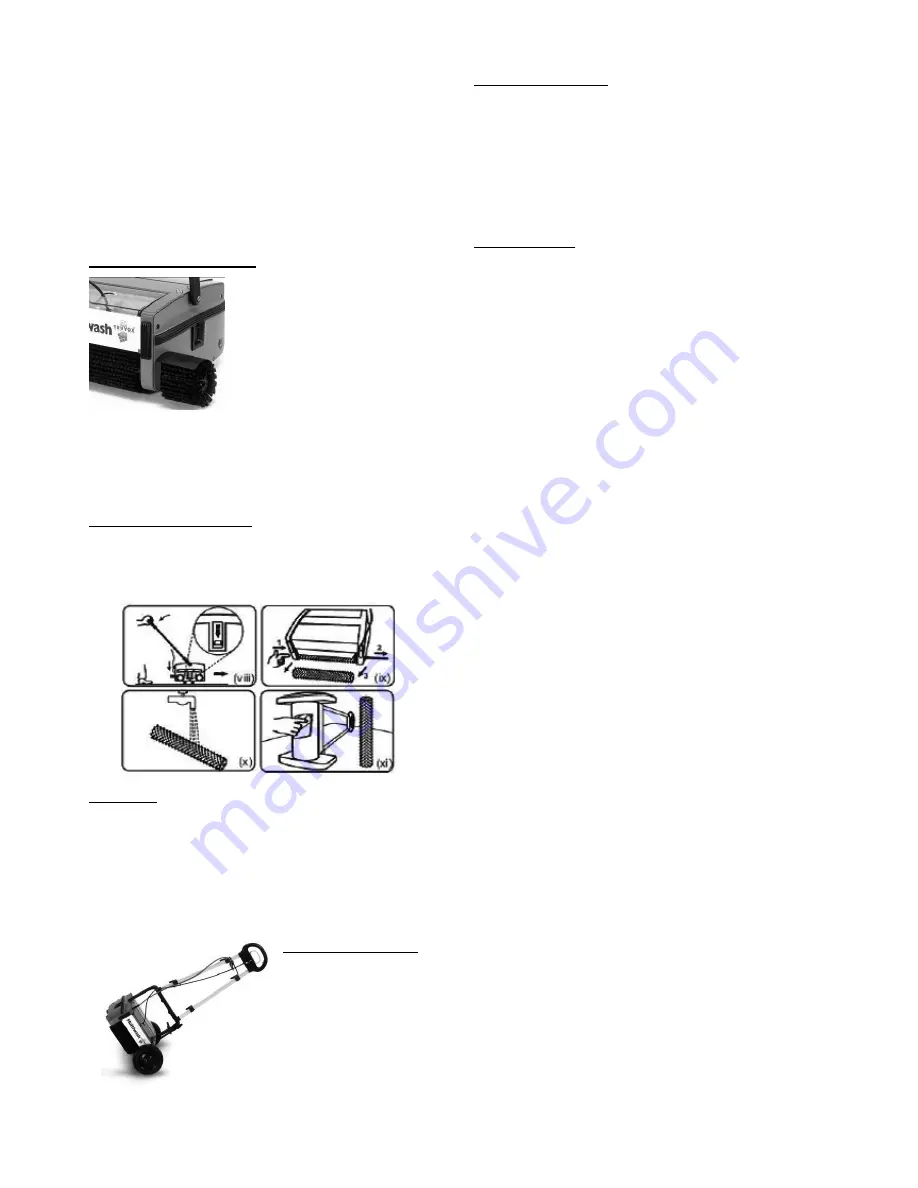
7
5. When you are changing the track allow some overlap
with the cleaned area. In case of large halls take a U-
turn and move forward. If quick drying is required,
move on the same track, without discharging the liquid
(Fig-v)
6. Clean the blades and push the tank into its place.
WARNING-
Pre-sweep the floor to remove debris before
using the Multiwash.
WARNING-
Avoid touching the sharp
edge of dirty water tank, it may cause injury to hands.
4.3 Fitting the side brush
To clean up to walls, the side
brush can be used. Switch off and
unplug the machine before fitting
the side brush.
WARNING
- Do not use side
brush in a room with no wall
skirting, otherwise, the wall may
get dirty.
1. Remove the front brush and brush shaft.
2. Fix the shield assembly on the side plate.
3. Insert the side brush through the shield and main
brush.
4.4 Using the side brush
1. Tilt the machine at an angle move forward. This way,
the dirty water thrown by the side brush will be
collected by the rear brush.
2. Use side brush only for washing the edges.
5. Storage
•
Always switch off, empty, wipe down and dry the
machine after use.
•
The tank should be emptied and flushed out with clean
water.
•
Wrap the supply cord around the cable winder ensuring
that the plug is not trailing on the floor.
•
Store the machine in a dry indoor area only.
5.1 Transport trolley
The simply fitted trolley
provides for ease of
movement when
transporting the machine.
WARNING
- Empty all
liquid from the machine
before using the
transporter.
5.2 Using the trolley
1. With the machine handle in the upright position place
the trolley centrally alongside the machine.
2. By holding the machine firmly, strap the Velcro with the
machine to fix the transporter.
3. Ensure that the Velcro strap is securely wrapped
around the bottom handle.
4. Now the trolley is ready to use. The machine can then
be manoeuvred easily whilst holding the top handle.
6. Maintenance
WARNING -
Before undertaking maintenance operations
or adjustments switch off machine and unplug from the
electricity supply.
IMPORTANT –
All other servicing and
repairs should only be performed by a Truvox engineer or
Authorised Service Agent.
IMPORTANT –
Should the
machine fail to operate please refer to the fault diagnosis
section in the back of this instruction manual. If the
problem / remedy is not listed please contact Truvox
Customer Service Department for rapid attention.
The machine requires minimum maintenance apart from
the following checks by the operator prior to use:
•
DO NOT
use aggressive detergents, acid, lye etc.
during cleaning and washing and take particular care
with electrical parts.
•
Supply cord - Regularly inspect sheath, plug and cord
anchorage for damage or loose connection. Only
replace the supply cord with the type specified in these
instructions.
•
Brushes - For maximum life, wash the brushes
regularly. Ensure machine is in Transport mode when
not in use. Store additional brushes in a vertical position
to avoid bending of bristles. Check for permanent
bending of bristles in a particular direction. This may
occur if the machine is operated for several days without
removing the brushes, which is not recommended. If
this occurs, reverse the brush so that the bent bristles
are automatically straightened.
•
Wiper Blade - After years of use the wiper blade may
wear. If this occurs the water collection performance will
decrease. It should be replaced by an authorised
service agent.
•
Solution tank filter (Standard) - The filter prevents
clogging of the drip holes in the tank. Periodically clean
the filter to ensure uniform discharge of liquid. In case of
non-uniform discharge from the drip holes, back flush
the tank in running
water. Clean the drip holes using
wire or a blunt pin.
•
Solution feed filter (Pump) - The filter prevents clogging
of the spray nozzle and should be periodically cleaned.
Use pressurised air/water for cleaning.
•
Nozzle maintenance (Pump)
- If the spray of the nozzle
becomes blocked, slide the nozzle cover off and remove
nozzle wash in clean water and clean using a pin and
refit.



































